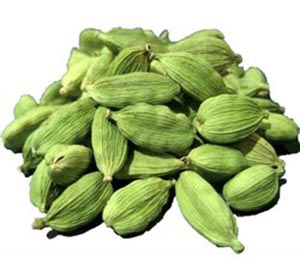Cardamom Nutrition facts
Cardamom is a seed pod spice recognized since ancient times for centuries for its culinary, and medicinal properties. This aromatic spice is native to the evergreen rain forest of southern Indian Kerala state.
Botanically, it belongs to the family of "Zingiberaceae" and consists of two genera; Elettaria and Amomum.
 |
| Green, dried cardamom pods. |
Both Elettaria and Amomum cardamom types feature three-sided fruits (pods) with a thin yet tough, papery outer shell. Inside, tiny, deep-brown, aromatic seeds are arranged in vertical rows with each grain ensheathed again inside a delicate, transparent membrane.
Elettaria pods are small and light-green, while Amomum pods are larger, and dark-brown. The seed pods are employed as a flavoring agent in food and drinks as well as in medicine.

|
| Black cardamom pods. Note for bigger-sized, dark brown pods. |
Black cardamom (Amomum subulatum), also known as Nepal cardamom (badi or kali elaichi in India, and Nepal), is relatively a big-sized pod in the same Zingiberaceae family.
A. subulatum features a dark-brown, tough cover, and measures about 2-4 cm in length and 1-2 cm in diameter. They possess a strong, camphor-like intense flavor, and are commonly employed in spice mixtures in sub-Himalayan plains of India, Pakistan, Nepal, and China.
Health benefits of Cardamom
This exotic spice contains numerous phytonutrients that are known to have anti-oxidant, disease-preventing, and health-promoting properties.
Cardamom pods carry many essential volatile oils that include pinene, sabinene, myrcene, phellandrene, limonene, 1, 8-cineole, terpinene, p-cymene, terpinolene, linalool, linalyl acetate, terpinen-4-oil, a-terpineol, a-terpineol acetate, citronellol, nerol, geraniol, methyl eugenol, and trans-nerolidol.
Cardamom essential oil has many therapeutic properties and found application in many traditional medicines as antiseptic, antispasmodic, carminative, digestive, diuretic, expectorant, stimulant, stomachic, and tonic.
Cardamom is a good source of minerals like potassium, calcium, and magnesium. 100 g pods contain 1119 mg of this electrolyte. Potassium is an important component of cells and body fluids that helps control heart rate and blood pressure. The human body uses copper for the production of red blood cells.
Additionally, it is also an excellent source of iron and manganese. 100 g pods contain 13.97 mg or 175% of the daily required levels of iron. Iron is required for red blood cell formation and cellular metabolism. Manganese is a co-factor for the enzyme, superoxide dismutase, a potent free-radical scavenger.
Further, these aromatic pods are rich in many vital vitamins, including riboflavin, niacin, and vitamin C which is essential for optimum health.
| Principle | Nutrient Value | Percent of RDA |
|---|---|---|
| Energy | 311 Kcal | 15.5% |
| Carbohydrates | 68.47 g | 52.5% |
| Protein | 10.76 g | 19% |
| Total Fat | 6.7 g | 23% |
| Cholesterol | 0 mg | 0% |
| Dietary Fiber | 28 g | 70% |
| Vitamins | ||
| Niacin | 1.102 mg | 7% |
| Pyridoxine | 0.230 mg | 18% |
| Riboflavin | 0.182 mg | 14% |
| Thiamin | 0.198 mg | 16.5% |
| Vitamin A | 0 IU | 0% |
| Vitamin C | 21 mg | 35% |
| Electrolytes | ||
| Sodium | 18 mg | 1% |
| Potassium | 1119 mg | 24% |
| Minerals | ||
| Calcium | 383 mg | 38% |
| Copper | 0.383 mg | 42.5% |
| Iron | 13.97 mg | 175% |
| Magnesium | 229 mg | 57% |
| Manganese | 28 mg | 1217% |
| Phosphorus | 178 mg | 25% |
| Zinc | 7.47 mg | 68% |
Selection and storage
Fresh cardamom pods, as well as their ground powder, are available in the market year-round. Either variety of cardamom is readily sold in the markets. "Elettaria" pods are small and light green, while 'Amomum" pods are larger and dark brown. Fresh pods should be heavy for their size and give a sweet aroma when rubbed with the fingertips.
Avoid buying if appears light and those with surface discoloration or spots, which may be a sign of mold infliction (fungal infections).
Medicinal use
The therapeutic properties of cardamom oil have found application in many traditional medicines as an antiseptic local anesthetic, and antioxidant, besides playing health-promoting and disease-preventing roles.
Culinary uses
In general, cardamom seeds are one of the most sought-after ingredients in sweet and dessert preparations. Split open the pod to remove seeds with fingers or using a small knife. The seeds are then crushed (powdered) using a pestle/mortar or hand-mill just before their addition to cooking. Often, whole pods are preferred in savory dishes, which give a further punch to the recipe since their peel also contains significant amounts of precious essential oils.
Here are some preparation tips:
-
This delicate spice is employed as a flavoring agent in foods, soups, and refreshing drinks.
The pods have been in use in the preparation of sweet dishes in many Asian countries. Elaichi-pista (cardamom and pistachio) kulfi is a popular summer dessert in India, Pakistan, and Iran. Elaichi kheer is another favorite rice pudding with added pistachio and raisins in these regions.
It is used as a flavoring base for the preparation of tea, coffee, and cold beverages.
Black cardamom (badi elaichi) preferred mostly in savory dishes; to prepare rice pilaf, meat stews, and lentil curry in many parts of Nepal, India, and Pakistan.
Safety profile
Use cardamom pods in small amounts. Too many spices in the food can cause gastrointestinal irritation and stomach ulcers. (Medical disclaimer).
≻≻-Back to Spices from Cardamom. Visit here for an impressive list of healthy spices with complete illustrations of their nutrition facts and health benefits.
≻≻-Back to Home page.
Further reading: